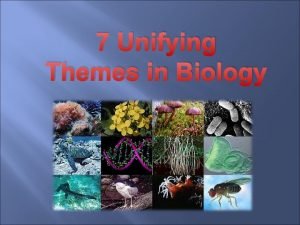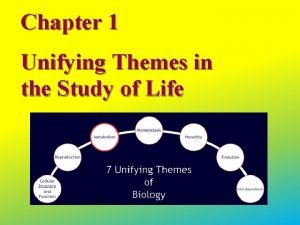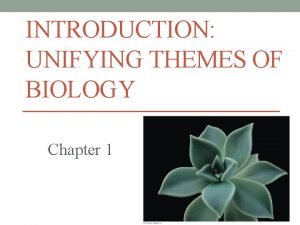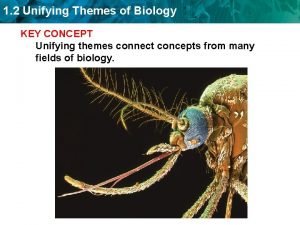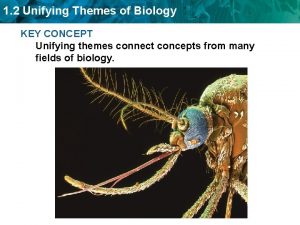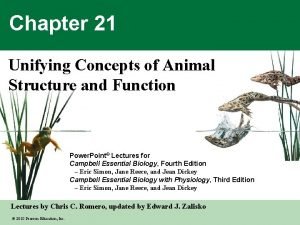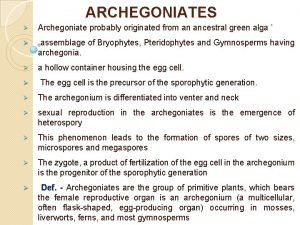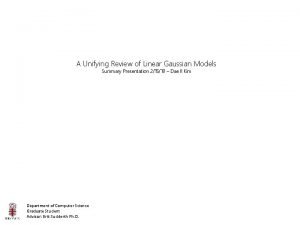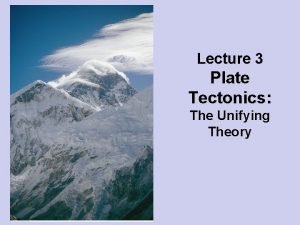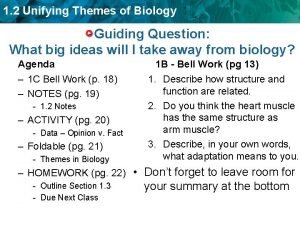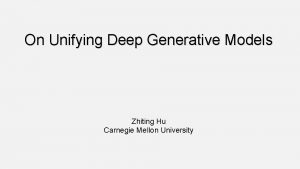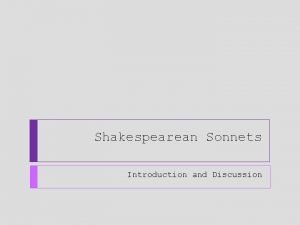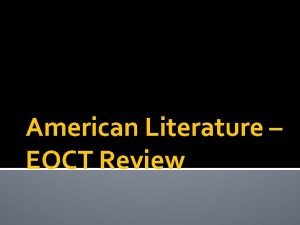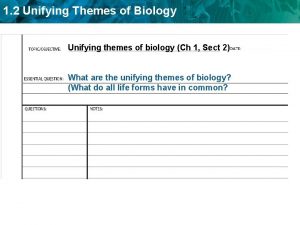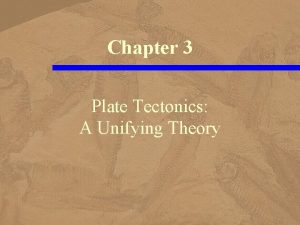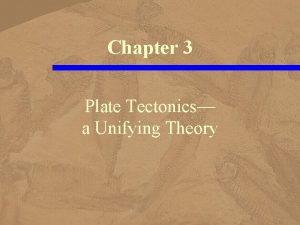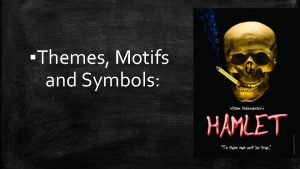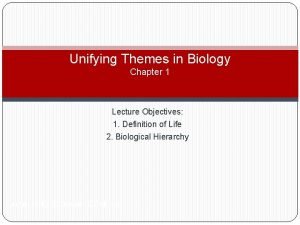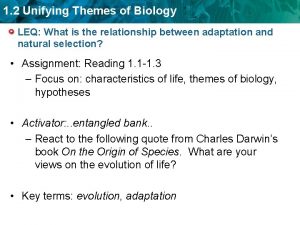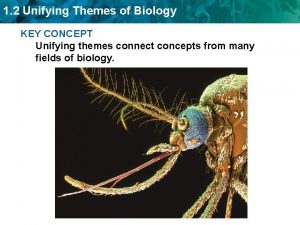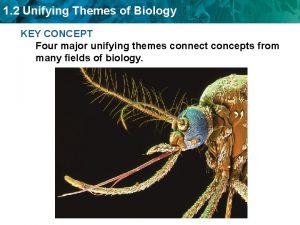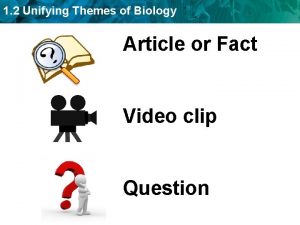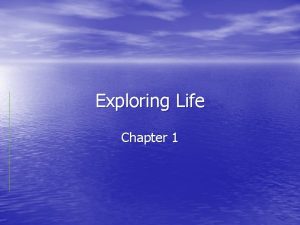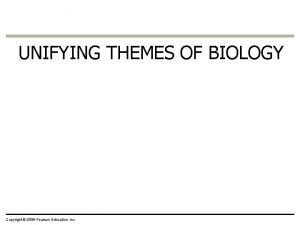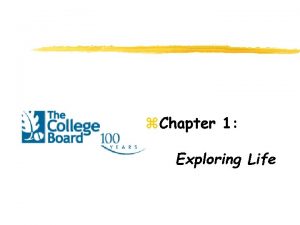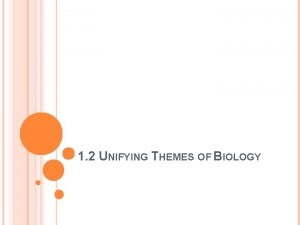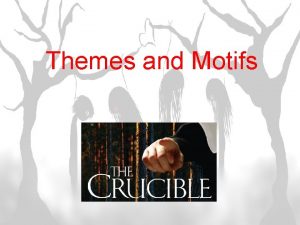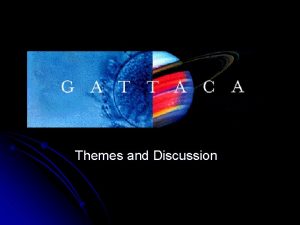UNIFYING AND COMMON THEMES IS THE STUDY OF


























- Slides: 26

UNIFYING AND COMMON THEMES IS THE STUDY OF LIFE CHAPTER 1 CONCEPT 1: COMMON THEMES IS THE STUDY OF LIFE CONCEPT 2: EVOLUTION CONCEPT 3: HOW SCIENTISTS STUDY NATURE CONCEPT 4: COOPERATIVE APPROACH AND DIVERSE VIEW POINTS.

BASIC CONCEPTS • Biology is the branch of science that deals with living organisms and vital processes. • Biologists study life at many different levels, from molecules to the global. • Evolution is the process of change over time. – Evolution accounts: • For the unity and diversity of life. • For the adaptation of organisms to their environment.

CONCEPT 1. BIOLOGICAL HIERARCHY • There is a hierarchy of structural levels. • At each level of organization, new properties appear (emerge). • Atoms molecules macromolecules → organelles → cells tissues organ systems organisms populations community ecosystem biosphere.

EMERGENT PROPERTIES • At each level of organization, new properties appear (emerge) as a result of the relative simple interactions of its components. • This emergent properties were not present in the previous in previous, simpler organizational levels. • These properties show the hierarchy of structural organization. • The emergent property cannot be reduced to the sum of its components. “The whole is greater than its components. ” • There is a correlation between structure and function.

REDUCTIONISM • Reductionism: taking a complex system apart into more manageable components in order to understand how it works. • Complex systems can be understood by studying its component parts. • We cannot explain a higher level of order by breaking it down into its components. • Systems biology: explore biological systems by analyzing the interaction of all of its parts.

THE CELL • The cells is the basic unit of structure and function. • All cells share certain characteristics. • Organelles are parts of the cell. – UNICELLULAR ORGANISMS – MULTICELLULAR ORGANISMS

• Prokaryotic cells LACK membrane-bound organelles and membrane-enclosed nucleus. • Eukaryotic cells HAVE membrane-bound organelles and a membrane-enclosed nucleus.

TWO BASIC TYPES OF CELLS • Prokaryotic cells Eukaryotic cells No nucleus Nucleus present One DNA Several DNA strands in nucleus Chromosomes with free ends Have membrane bound organelles Circular DNA, no free ends Lack membrane bound organelles

The Cell’s Heritable Information • Life processes involve the expression and transmission of genetic information. • The continuity of life is based on heritable information in the form of DNA (deoxyribonucleic acid). • DNA is made of a double helix. • Each strand of the helix is made of four kinds of molecules called nucleotides. • The sequential arrangement of these four nucleotides contain encoded the precise information of a gene. This arrangement makes the genetic code.

GENES • Genes are made of DNA. • Genes are the units of inheritance that transmit information from parents to offspring. • RNA is an intermediary molecule between the DNA genetic code and the cell product. • Gene expression refers to the cellular product. – Genomics: large scale analysis of whole sets of genes. – Proteonics: large scale analysis of sets of proteins. – Bioinformatics: use of computers to analyze and store large volumes of data.

3. TRANSFER AND TRANSFORMATION OF ENERGY • The sun is the ultimate source of the energy used by organisms. • Photosynthesis transforms radiant (light) energy into chemical energy that is used by organisms. • Photosynthetic organisms are called producers. • Consumers are organisms that feed on producers. • Energy flows through the ecosystem entering as light energy and eventually leaving as heat.

4. Organisms interact with their environment • Organisms exchange matter and energy with their environment. – Living and non-living environment. – Molecules interact within the body of organisms. • Feedback mechanisms regulate biological systems. • In feedback regulation, the product or output regulates the very process that produces it. • There are positive and negative feedback mechanisms.

CONCEPT 2: EVOLUTION • Evolution accounts for the unity and diversity of life. • Biologists have identified about 1. 8 million species. – – – 5, 200 prokaryotes 100, 000 fungi 290, 000 plants 52, 000 vertebrates 1, 000 insects Total number of species: 10 to 100 million (estimate).

Grouping of organisms: the basic concept. • Taxonomy is the science of classifying organisms. • The species is basic unit of classification. • Taxonomic classification is hierarchical: each level consists of groups of the previous lower level. – Bacteria and Archaea are prokaryotic organisms. – Eukarya is a eukaryotic domain

THREE DOMAINS OF LIFE • Species genus family order class phylum (division) kingdom domains • The broadest unit of classification is the domain. • All living organisms are classified into one of three domains: Bacteria, Archaea and Eukarya. • Four kingdoms in the Eukarya: Protista, Fungi, Plantae and Animalia.

UNITY IN DIVERSITY • There is unity in the diversity of life. • This unity is evident in: – The universal genetic code. – Similar metabolic pathways or cell functions. – Similar cell structure

CHARLES DARWIN AND THEORY OF EVOLUTION • Species change over time. This documented by the fossil record and other evidence. • In 1859, Charles Darwin published The Origin of Species in which he made two major points: – Species change, and contemporary species arose from a succession of ancestors through a process of "descent with modification. ” – A mechanism of evolutionary change is natural selection.

DARWIN’S THEORY • Darwin made the following observations: – Individuals in a population vary in many inheritable traits. – Populations have the potential to produce more offspring than will survive or than the environment can support. – There is competition or a struggle for existence. – Individuals with traits best suited to the environment leave a larger number of offspring, which increases the proportion of inheritable variations in the next generation.

NATURAL SELECTION • This differential success in reproduction is what he called natural selection. • Natural selection does not create adaptations. It merely increases the frequency of inherited variants that arise by chance. • Natural selection is NOT theory of evolution. It is the MECHANISM of evolution.

TREE OF LIFE • An illustration of evolutionary relationship. • This connection between species and its ancestors more and more remote is refer as the Tree of Life in which each species is a “twig” of the “tree”. • Each branch represents the common ancestor of the lineages originating there.

CONCEPT 3: THE STUDY OF NATURE • Inquiry is a search for information and explanation. • Data can be quantitative and qualitative. • Inductive reasoning begins with observations and draws conclusions: general principle. – What do all these facts have in common? – From many examples to all possible examples: inductive leap. • Inductive conclusions are generalizations that summarize many concurrent observations.

WHAT IS A HYPOTHESIS? • A hypothesis is a tentative answer to some question. It is an educated guess. • Hypotheses must be testable. • Science cannot address the possibility of supernatural phenomena nor the validity of religious beliefs.

SCIENTIFIC METHOD • Requires evidence to logically solve problems. • Make observations. Curiosity. • Ask critical questions. • Do background research, e. g. review of the literature; talk to scientists. • Formulate hypothesis: • - A hypothesis is an educated guess proposed as a tentative answer to a specific question or problem. • Predictions are logical consequences of the hypothesis. – Make a prediction that can be tested. • Test the prediction: controlled experimentation.

CONTROLLED EXPERIMENT • Control group: in a controlled experiment, the groups in which all variables are held constant. • The experimental group differs from the control group in only one variable. – Both groups are then compared. • Collect data. Recorded observations are called data (sing. datum) – One datum; two data. • Interpret data. • Draw conclusions. • Hypothesis supported or not.

SCIENTIFIC THEORY • A theory in science is a comprehensive explanation supported by abundant evidence, which is widely accepted by the scientific community. • A theory is validated by a continuum of observations and experiments. • A theory is general enough to spin off many new, specific hypotheses that can be tested.

CONCEPT 4: SCIENCE IS A SOCIAL PROCESS • Cooperative approach and diverse viewpoints. • Scientists build on the work of other scientists that have come before. • Technology is a method or devise that applies scientific knowledge for some specific purpose.
 5 themes of biology
5 themes of biology The biological hierarchy
The biological hierarchy 4 unifying themes of biology
4 unifying themes of biology What are the unifying themes in biology
What are the unifying themes in biology 5 unifying themes of biology
5 unifying themes of biology Unifying concepts of animal structure and function
Unifying concepts of animal structure and function Unifying features of archegoniate
Unifying features of archegoniate A unifying review of linear gaussian models
A unifying review of linear gaussian models Unifying theory of plate tectonics
Unifying theory of plate tectonics Unifying theme definition
Unifying theme definition Oracle healthcare data model
Oracle healthcare data model Zhiting hu
Zhiting hu Greatest common factor of 20 and 36
Greatest common factor of 20 and 36 Common anode and common cathode
Common anode and common cathode 56 prime factorization
56 prime factorization Highest common factors and lowest common multiples
Highest common factors and lowest common multiples Find the lcm of 16 24 36 and 54
Find the lcm of 16 24 36 and 54 Multiples of 9 and 21
Multiples of 9 and 21 Religion analysis
Religion analysis Where is the setting of the folktale
Where is the setting of the folktale Sonnet 148
Sonnet 148 Early american literature themes
Early american literature themes Hát kết hợp bộ gõ cơ thể
Hát kết hợp bộ gõ cơ thể Frameset trong html5
Frameset trong html5 Bổ thể
Bổ thể Tỉ lệ cơ thể trẻ em
Tỉ lệ cơ thể trẻ em Gấu đi như thế nào
Gấu đi như thế nào
